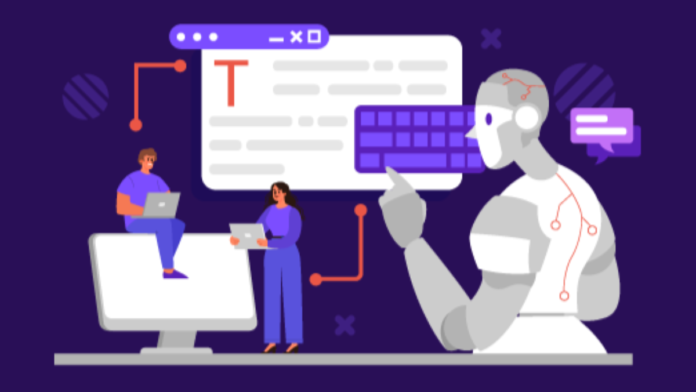Generative AI is one of the significant breakthroughs in content creation. It leads to developing state-of-the-art systems that can create human-like text about any issue, thus opening new possibilities.
Generative automated tools help creators work better since they don’t have to rote drafting tasks and unlock unprecedented efficiency in producing content that captures viewers’ attention.
This article explores five compelling applications of generative writing assistants that redefine ideation, accelerate drafting, and streamline editing.
1. Automated Content Generative AI: Enhancing Efficiency and Scale
For writers and content creators, few capabilities from AI are more enticing than automated text generation. Notably, some platforms can generate entire articles from a title or brief prompt, creating drafts humans can edit and finalize. This allows creators to produce much more content in the same timeframe.
AI-generated drafts save time on initial research and writing, letting creators focus their efforts on the most meaningful topics and ideas. The models pull together cohesive, grammatically correct content that hits the key points the user indicated. Creators can control length, tone, and other attributes during generation.
This enhanced efficiency also allows individual creators or small teams to operate at a much larger scale. Tasks that may have taken dozens of content writers can now be achieved by fewer people leveraging AI. This efficiency lets creators try more ideas, pursue more topics, and better meet audience demand.
2. Augmented Creativity with AI-assisted Design
Graphic designers have limitless imagination associated with the invention of visual AI systems. Prompts like “futuristic city skyline” or “ornate flower vector icon” enable designers to generate many images, icons, 3D models, etc. automatically.
For instance, generative AI platforms like Hotpot.ai are unlocking transformative possibilities for augmented creativity in visual content design. As an AI-driven image generator, Hotpot is a design companion that can create professional graphics and mockups in minutes based on initial prompts signaling purposes.
Designers provide descriptive prompts and can instantly generate numerous matching images. Rather than simply pulling from a static library of stock visuals, Hotpot and tools like it procedurally generated novel images on demand that match the indicated description.
This effectively automates the ideation step of design, providing an unlimited spring of creative jumping-off points. Designers can pick the best outputs, indicate desired tweaks through added prompts, and generate further iterations in minutes instead of hours or days.
3. Content Enhancement through Sentiment Analysis
Creators who handle topics related to complex real-life issues or diverse views can make use of AI so that their work will show sensitive, fair, and accurate positions.
Sentiment and bias detection algorithms scan draft articles and scripts for offensive, alienating, and deceptive passages. All subject matter can be treated judiciously via the creators’ ability to change the wording, add caveats, or expand the context.
This makes it possible to touch on political, social, environmental, and sensitive issues while striving to preempt miscommunication. In addition, generative writing enables co-authoring content on a go basis and checking appropriateness simultaneously.
4. Collaborative Storytelling with AI-generated Plot Points
Fiction creators like authors, screenwriters, and video producers can utilize AI assistants that suggest or continue storylines based on prompts. Writers provide initial characters, settings, genres, or other creative directions, then leverage models to interactively build plots.
The AI keeps tone, facts, and constraints consistent while developing new narrative twists and character moments that fit creators’ styles. Writers maintain control to accept, reject, or modify generated plot milestones. This boosts productivity, provides a fresh outside perspective, and reduces writer’s block.
Groups can use these tools collaboratively for “exquisite corpse” style real-time story ideation. Participants take turns setting plot waypoints or writing passages handed off to others. The AI makes suggestions to forward action and smooth transitions between sections. This facilitates productive collective brainstorming.
5. Personalized Content Tailored to Audiences
Understanding users and crafting content specifically for them has always been vital for creators seeking engagement. AI now provides data-driven tools to dynamically customize content at scale to best resonate and convert for each audience.
Contextual recommendation algorithms can determine how to format, emphasize, and augment content for specific users based on models of their interests and traits. Personalized subject lines, dynamic layouts, and expanded or condensed passages on specific topics are all possible.
Creators feed the AI general content and then let the personalization algorithms tailor it for each recipient. This empowers mass customization unmatched manually, keeping users engaged versus broad one-size-fits-all content.
Final Thoughts
Modern, powerful, generative AI marks a milestone in creativity, empowering diverse, bright instruments for creatives. Despite quickly replacing human creations in improving safety and capability, creators remain irreplaceable for their ingenuity, purpose, and meaning.
On the contrary, AI removes repetitive and tedious tasks, while opening new creative possibilities. This increases the speed, reduces fatigue, and enhances creativity across all content types. It allows for personalization, collaboration, and ethical protection, none of which could have been done at scale. Generative AI envisages a renaissance of supplemented artificial skills that enculturates to thrive afresh. Creation’s future is certainly looking brighter.















